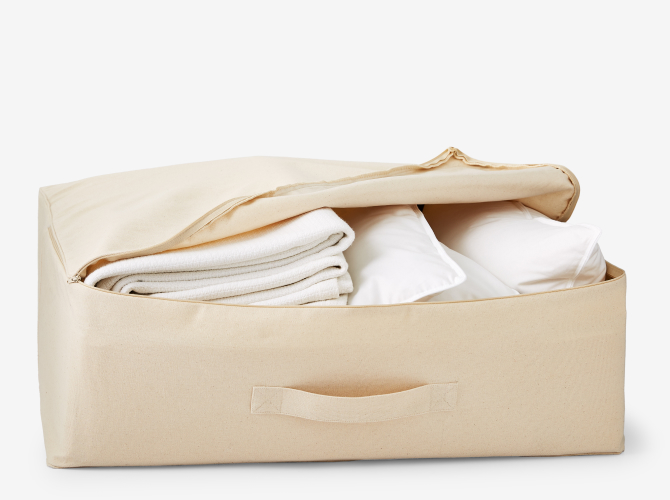
How to Clean Pillows
While pillows require laundering less often than sheets and other bedding, they’ll be at their best when they’re fresh and clean. When it comes to caring for your down or down alternative bed pillows or throw pillow inserts, these washing directions and basic storage tips are a good place to start. Nothing beats the manufacturer’s instructions—but we’ve gathered up the most important pillow care details here for easy reference.
How to Wash and Dry Pillows
For best results, refer to the care instructions included with your pillow before washing it. If you no longer have the instructions, consider these basic steps for cleaning down or down alternative pillows in the washing machine.
Most down and down alternative pillows are machine washable. Remove the pillow covers and wash those separately. For best results, use a washing machine without an agitator, and choose the gentle cycle.
Stains on pillows or pillow covers can be spot treated prior to washing, but read all labels to determine which treatments are safe for down, as well as which may damage decorative stitching or appliqué. Use a mild dish detergent and water solution to blot messes away, or pre-treat with a pillow-safe stain remover product.
Don’t use bleach or laundry additives like fabric softener as they can damage the fill and reduce the pillow’s lifespan.
For a balanced load, wash pillows two or three at a time. An unbalanced load can damage the machine or leave your pillows soggy at the end of the spin cycle.
Warm water is okay, but cold is better for both wash and rinse cycles. Detergent residue build-up makes down fill clump, but a second cold rinse cycle can help get rid of any lingering detergent.
Most pillows can be put in the dryer on a low-heat setting. Try shaking and fluffing the pillows a few times during the cycle to ensure they dry evenly.
To avoid a musty smell and to prevent mold, ensure your pillows are completely dry before use or storage. To learn more about bedding storage, check out our complete guide.
Quick Tip:
Tossing in wool dryer balls during drying helps prevent the fill from clumping and will fluff the pillows.
How Often Should You Wash Pillows?
How often you wash your down or down alternative pillows depends on a few factors. While washing pillows seasonally—every four months—may be enough for some people, if you share your bed with pets or have allergies, you may want to wash your pillows every two months. Using a protective pillow cover can keep irritants and allergens from getting inside the fill, keeping your pillow fresher, longer.
If you need to refresh your pillow between washes, try these techniques for re-fluffing your bed or throw pillows.


1
Fluff down pillows by hand—simply shake the fill around to redistribute it
2
If the care label states that your pillow can go into the dryer, you can use a short, low-temperature cycle to restore the loft between washing. Add wool dryer balls to break up lumps and redistribute the fill.
3
Leaving your pillow in the sun can help air it out and dry up any moisture that’s causing lumps of fill. After you air it out, you can gently knead the fill to promote airflow to add more loft to your pillow.
4
If none of these techniques work, residue inside the fill may be to blame. After washing, run an extra rinse or two to wash away any build-up.
If you’ve tried to re-fluff your pillows but they’re still lumpy, flat, or uncomfortable, or if you just can’t get rid of that musty smell, it may be time to replace your pillows.
Quick Tip:
Pillowcases are more than decorative: these covers protect your bed pillows and throw inserts from debris and damage, which means less laundry for you—and a longer lifespan for your pillows.
The Right Way to Store Pillows
Storing guest pillows or extra toss pillows? Extend the lifespan of your pillows by making sure you’re storing them correctly.


- Take care not to stack items on top of your pillows—especially down pillows—as the weight can damage the fill and leave them flat or lumpy.
- Avoid storing your bedding in plastic containers—storing your pillows in breathable cotton bags or baskets helps prevent a musty scent.
- Keep bedding out of damp storage spaces: pillows should be stored in linen closets or drawers rather than basement storage areas to prevent mold and mildew damage.
Quick Tip:
if you’ve pulled your pillows out of storage only to find that they have a musty smell, you can air them out in a sunny spot for a few hours to freshen them and get rid of the scent.
We can’t get enough pillows—and this guide helps make washing and caring for pillows easy. Keep your pillows clean, fresh, and ready for a comfortable night’s rest—and check out our Tips & Ideas page for more bedding and decorating tips.
